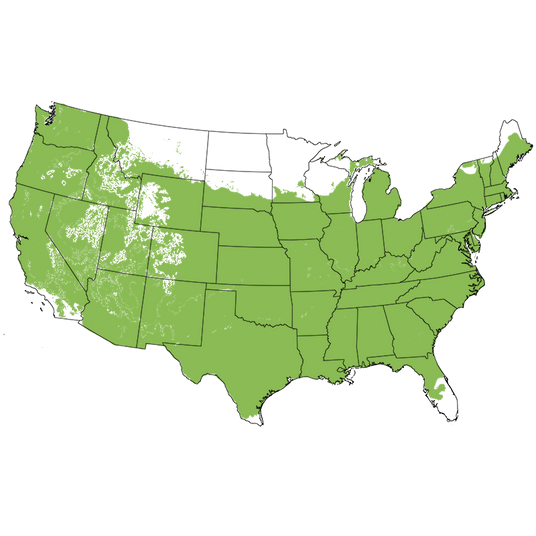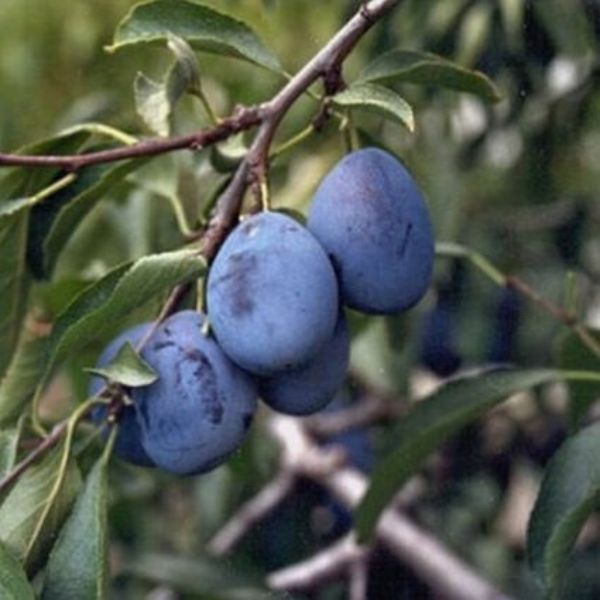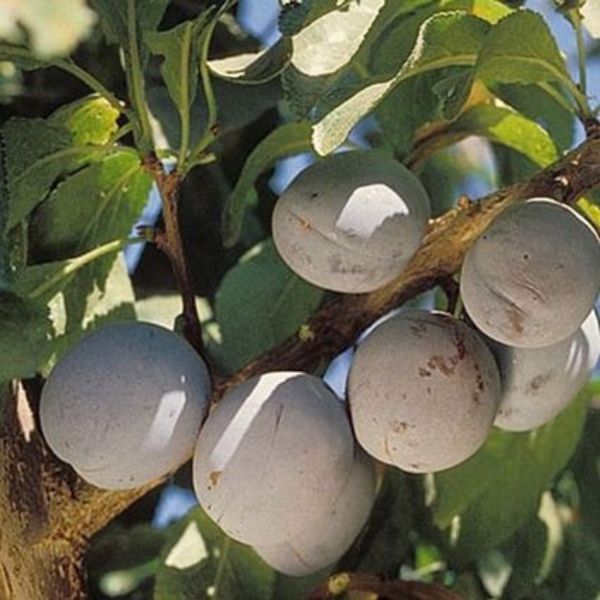Italian Plum Tree
Prunus 'Italian'
Plant Sentry™
Plant Sentry™

Plant Sentry™ Protected
Your order is protected by our compliance system that:
- Prevents restricted plants from shipping to your state
- Ensures plants meet your state's agricultural requirements
- Protects gardens from invasive pests and diseases
Delivery and Shipping
Delivery and Shipping
Delivery and Shipping
Fast, Safe Plant Delivery
Ships in 3-4 business days • Tracking provided • Weather protected
| Under $50 | $9.99 |
| $50 - $99.99 | $14.99 |
| $100 - $149.99 | $16.99 |
| $150 - $198.99 | $24.99 |
| $199+ | FREE |
✓ Zone-specific timing • ✓ Professional packaging • ✓ Health guarantee
Understanding Plant Options
Nature Hills offers plants in two main formats:
- Container Plants: Grown in pots with soil, sized by container volume and plant age
- Bare Root Plants: Dormant plants without soil, sized by height measurements
Container Plant Sizes
Container sizes indicate plant age and growing capacity rather than liquid volume equivalents. Our containers follow industry-standard nursery "trade gallon" specifications, which differ from standard liquid gallon measurements.
Young Plants (6 months to 18 months old)
| Container Size | Actual Volume | Metric Equivalent |
|---|---|---|
| 2" x 2" x 3" | 0.18 - 0.21 dry quarts | 0.20 - 0.23 dry liters |
| 4" Container | 0.31 - 0.87 dry quarts | 0.35 - 0.96 dry liters |
| 4.5" Container | 0.65 dry quarts | 0.72 dry liters |
| 6" Container | 1.4 dry quarts | 1.59 dry liters |
| 1 Quart | 1 dry quart | 1.1 dry liters |
| 5.5" Container | 1.89 dry quarts | 2.08 dry liters |
Established Plants (18 months to 2.5 years old)
| Container Size | Actual Volume | Metric Equivalent |
|---|---|---|
| 2 Quart | 2 dry quarts | 2.2 dry liters |
| #1 Container | 2.26 - 3.73 dry quarts | 2.49 - 4.11 dry liters |
| 5" x 5" x 12" | 3.5 - 4.3 dry quarts | 3.85 - 4.74 dry liters |
Mature Plants (2-4 years old)
| Container Size | Actual Volume | Metric Equivalent |
|---|---|---|
| #2 Container | 1.19 - 1.76 dry gallons | 5.24 - 7.75 dry liters |
| #3 Container | 2.15 - 2.76 dry gallons | 8.14 - 12.16 dry liters |
Large Plants (3-5 years old)
| Container Size | Actual Volume | Metric Equivalent |
|---|---|---|
| #5 Container | 2.92 - 4.62 dry gallons | 12.86 - 20.35 dry liters |
| #6 Container | 5.25 - 6.01 dry gallons | 23.12 - 26.42 dry liters |
| #7 Container | 5.98 - 6.53 dry gallons | 26.34 - 28.76 dry liters |
Bare Root Plants
Bare root plants are sold by height from the root system to the top of the plant. Plants may exceed minimum height requirements.
Common Sizes:
- Trees: 1 foot, 2 feet, 3 feet, 4 feet, 5 feet, 6 feet
- Shrubs & Perennials: 1 foot, 18 inches, 2 feet
Important Notes
Container Volume Specifications
- Trade Gallon Standard: Our containers follow industry-standard "trade gallon" specifications established by the American National Standards Institute (ANSI Z60.1) for nursery stock
- Volume Variations: Actual soil volume may vary due to plant root systems and growing medium settlement
- Age Indicators: Container size primarily indicates plant age and maturity rather than liquid volume equivalents
Growing Conditions
- Plant size can vary based on variety and growing conditions
- Container size helps indicate plant maturity and establishment level
- Larger containers generally mean more established root systems and faster landscape establishment
Seasonal Availability
- Bare root plants are available seasonally when dormant
- Container plants are available throughout the growing season
- Specific varieties may have limited availability in certain sizes
Questions?
For questions about specific plant sizes or availability, please contact our plant experts who can help you choose the right size for your landscape needs.

Plant Sentry™ Protected
Your order is protected by our compliance system that:
- Prevents restricted plants from shipping to your state
- Ensures plants meet your state's agricultural requirements
- Protects gardens from invasive pests and diseases
Plant Profile & Growing Essentials
Attracts pollinators, Edible, Flowering, Drought resistant, and Self-pollinating
Specifications
Specifications
-
Botanical Name
-
Height
-
Width
-
Growing Zones
-
Sunlight
-
Growth RateModerate
-
Leaf Color
-
Pollinator FriendlyYes
-
Pollinator Required
-
Bloom PeriodLate Spring
-
FragrantYes
Planting & Care Instructions
Planting & Care Instructions

Growing Zones 5-9
Easy-Care Tree & Versatile Fruit Italian Plum Tree
- Superior Flavored Fruit
- Dark Blue-Black Skin
- Very Sweet Yellow Flesh
- Dried, Eat Fresh & Preserves
- Freestone Plums
- Self-Fruitful
- Adaptive To A Variety Of Soils
- Pinkish-White Blooms
- Fragrant & Calls Pollinators
- Smaller Size Canopy
- Lush Green Foliage
- August Harvest
- ~800 Chill Hours
Italian Plum Tree (Prunus 'Italian') is a fruit-bearing tree that provides a harvest of versatile fruit of superior quality. Delightful orchard favorites for a reliable harvest and versatility in the landscape and kitchen!
Your Italian Plum Tree features a spring bloom of lovely pink and white blossoms, but it of course most beloved for its August harvest of delectable, freestone sweet, dark purple fruit. In fact, Italian Plums are among the most popular you can buy and often dried as prunes.
Not only delicious and versatile but also beautiful, Italian Plums are medium-large with a dramatic, purple-black skin and green-hued, yellow flesh. When cooked, the juice transforms to a deep red that is a breathtaking addition to culinary dishes.
They're incredibly versatile, being used in canning, cooking...and of course sumptuous eaten fresh. The sweet flavor is a rich blend of sweetness with a lemon-tart edge that sets it apart from the common taste of other plums.
How to Use Italian Plum Tree In The Landscape
Italian Prune Plum Trees form a dense canopy, and the size of these trees makes them fantastic for tucking into established landscapes and existing orchards! Perfect for shading garden beds and seating areas while still allowing the delectable fruit to be within easy reach!
An Italian Plum would be adorable near your front door where you can enjoy it every time you walk by. Plant outside a window where you’ll always be able to keep tabs on your developing fruit!
An ideal ornamental flowering specimen and accent tree for dual-purpose gardening use! These beautiful trees enhance the landscape year-round.
#ProPlantTips For Care
Plant one in a spot with good drainage and full sun although it will tolerate just a touch of shade in the hottest growing zones of 5 through 9.
Provide ample water during establishment, not allowing it to dry out between waterings. Watering older trees moderately, yet consistently during the heat of summer and when fruiting.
Adaptable to a variety of soil types, any fertile, well-drained soil is fantastic. Italian Plum doesn't need a pollinator to produce a harvest but does better with another European Plum pollinator. A generous layer of mulch helps retain soil moisture as well as insulate the root system from heat and chill.
It's considered an easy tree to get established and can be expected to bear fruit within only two years. Low maintenance, prune to keep an open canopy so that both sunlight and airflow reach the interior. Our Garden Blog has more Fruit Tree Planting, Fruit Tree Pruning and Plum Tree Care information!
For a Plum with exceptional flavor and a multitude of uses, Italian Plum is the choice for you. With very little effort, you can expect a heavy harvest of some of the most delicious plums you've ever tasted. Try one today by ordering at NatureHills.com!
Plum Tree Frequently Asked Questions
How long does it take for Italian Plum Trees to bear fruit?
Nature Hills Nursery sells fruit trees with mature root systems that are already three to four years old, so you’ll enjoy fruit sooner than you would with younger trees! Expect young Plum trees to begin fruiting usually by the 2nd to 4th year after they establish in your landscape.
How big do Italian Plum trees grow? How fast do Plum trees grow?
The Italian Plum tree can grow to a mature height of 15-20 feet and a mature width of 12-20 feet.
Once your Plum tree has been established (after the first year), it can typically add 13-24 inches of new growth per growing season. If your plants are growing less than that in a season, it may be worth your while to check the fertility level.
Where is the best place to plant a Italian Plum Trees?
Plum trees grow best in well-drained, fertile soil in at least 6 hours of full sun per day or more. Provide good air circulation and moderate, yet consistent water in well-drained, fertile soil.
Do You Need 2 Plum Trees to Produce Fruit?
The Italian Plum trees are self fertile, so planting more than one Plum tree that blooms at about the same time, boosts yields on both trees and extends your harvest time!
No room? Look into High-Density Planting techniques, or choose a semi-dwarf or dwarf fruit tree.
When Should Italian Plum Tree be Planted?
Bareroot Plum trees can be planted in spring when they are available in your area. Container-grown Plum trees can be very successfully transplanted all throughout the growing season. Check for first and last frost dates for your area with your local County Extension Office.
- Plant bareroot Plum trees in the early spring.
- Plant container-grown trees anytime the ground is not frozen by digging a hole as deep as the soil line and twice as wide.
How Do I Find Italian Plum Trees for Sale Near Me?
Make your life easier and your landscape tastier by shopping for Plum trees at NatureHills.com online fruit tree nursery. You’ll find a massive selection of fruit trees for sale, including many lovely Plum tree varieties!
Choose the right tree for your area by first finding your USDA growing zone by entering your zip code in the field above the Plant Highlights section on our product pages. Narrow down your options by plant hardiness zone, sun availability, and size requirements.
Place your order, knowing it’s backed by the Nature Hills Nursery product guarantee and protected by Plant Sentry™, which helps ensure regulated plant materials aren’t sent to prohibited areas.
Expect to receive your plants at the appropriate planting time for your growing zone when temperatures are safest for those plants that ship in fall, winter, or early spring.
Shop the selection of mature Plum trees for sale at Nature Hills Nursery and place your order for Italian Plum Tree today.
What shipping options do you offer?
NatureHills.com works closely with our growers and nursery professionals to ensure we ship when it is most appropriate for your area. Our goal is to deliver the hardiest plants by avoiding extreme high and low temperatures. Check out our shipping schedule for more information and to learn our wills and won’ts when it comes to shipping plants. Find your Italian Plum Tree for sale here at NatureHills.com!
Super Healthy, Ancient Fruit
The history of the Italian Plum may be the history of the Prune Plum itself. Thought to have originated around 2,000 years ago in Eastern Europe, this hybrid of the Wild Plum is currently thought to be a 6x cross of Prunus cerasifera, most likely an example of natural selection and human selection working together to evolve a new species, Prunus domestica.
In ancient Rome there were reports to be over 400 varieties of European Plums cultivated. Most likely the modern Italian Prune Plum was amongst these many early selections. The Empress Plum, as the Italian Prune Plum is sometimes referred to, has been in cultivation for well over 2,000 years.
As early as the early 1800's, European Prune Plums were being planted and marketed in the United States. It is noted that by the 1850's, the Pacific Northwest of the United States and throughout California, Prune Plums were being planted and consumed locally as well as dried for shipping.
In the 1920's, the Oregon market expanded, particularly around the Willamette Valley where the Italian Prune Plum was the fruit of choice for both local consumption and export. The dry Prune Plum had become a valuable food source due to its ability to be dried, shipped and stored.
Some say that only the Italian Plum can call itself a "prune" when dried; and all other varieties of Prunus domestica just dried plums. This is most likely do to the high concentration of fermentable sugars. The Italian Prune Plum maintains its sweet flavor during drying and does not ferment around the pit as many varieties are prone to do.
Even though people wouldn't have been able to quantify the health benefits of the Italian Prune Plum historically, they certainly knew prunes were a healthy food source. Today, we know a lot more about why they are considered so healthy, including high concentration of valuable nutrients such as potassium, Vitamin C, the important B complex Vitamins, valuable antioxidants sourced in the dark skin and dietary fiber.
Although the Italian Prune Plum thrives in the typical arid climate with low winter temperatures and long hot summers similar to the region where it originated; over time the variety has been shown to adapt to a wide range of climates conditions. Today, the Prunus domestic (European Plums) are some of the most popular varieties of fruit grown in the colder regions of the world. The Italian Prune Plum is still one of the most popular home garden Prune Plum selections in USDA zones 5- 9.










